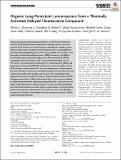Organic long persistent luminescence from a thermally activated delayed fluorescence compound
Date
10/11/2020Author
Grant ID
EP/P010482/1
EP/P010482/1
EP/J01771X/1
EP/R035164/1
EP/R035164/1
Keywords
Metadata
Show full item recordAbstract
Organic long‐persistent luminescence (OLPL) is one of the most promising methods for long‐lived‐emission applications. However, present room‐temperature OLPL emitters are mainly based on a bimolecular exciplex system which usually needs an expensive small molecule such as 2,8‐bis(diphenyl‐phosphoryl)dibenzo[b,d]thiophene (PPT) as the acceptor. In this study, a new thermally activated delayed fluorescence (TADF) compound, 3‐(4‐(9H‐carbazol‐9‐yl)phenyl)acenaphtho[1,2‐b]pyrazine‐8,9‐dicarbonitrile (CzPhAP), is designed, which also shows OLPL in many well‐known hosts such as PPT, 2,2′,2″‐(1,3,5‐benzinetriyl)‐tris(1‐phenyl‐1‐H‐benzimidazole) (TPBi), and poly(methyl methacrylate) (PMMA), without any exciplex formation, and its OLPL duration reaches more than 1 h at room temperature. Combining the low cost of PMMA manufacture and flexible designs of TADF molecules, pure organic, large‐scale, color tunable, and low‐cost room‐temperature OLPL applications become possible. Moreover, it is found that the onset of the 77 K afterglow spectra from a TADF‐emitter‐doped film is not necessarily reliable for determining the lowest triplet state energy level. This is because in some TADF‐emitter‐doped films, optical excitation can generate charges (electron and holes) that can later recombine to form singlet excitons during the phosphorescence spectrum measurement. The spectrum taken in the phosphorescence time window at low temperature may consequently consist of both singlet and triplet emission.
Citation
Li , W , Li , Z , Si , C , Wong , M Y , Jinnai , K , Gupta , A K , Kabe , R , Adachi , C , Huang , W , Zysman-Colman , E & Samuel , I D W 2020 , ' Organic long persistent luminescence from a thermally activated delayed fluorescence compound ' , Advanced Materials , vol. 32 , no. 45 , 2003911 . https://doi.org/10.1002/adma.202003911
Publication
Advanced Materials
Status
Peer reviewed
ISSN
0935-9648Type
Journal article
Description
Funding: UK EPSRC (grants EP/ P010482/1, EP/J01771X, EP/J00916, and EP/R035164/1). We gratefully acknowledge funding through the EPSRC NSFCBET lead agency agreement (EP/R010595/1,1706207) and a Leverhulme Trust Research Grant (RPG-2017-231).Collections
Items in the St Andrews Research Repository are protected by copyright, with all rights reserved, unless otherwise indicated.
Related items
Showing items related by title, author, creator and subject.
-
Unusual intermolecular “through-space” J couplings in P–Se heterocycles
Sanz Camacho, Paula; Athukorala Arachchige, Kasun Sankalpa; Slawin, Alexandra Martha Zoya; Green, Timothy F.G.; Yates, Jonathan R.; Dawson, Daniel McLean; Woollins, J Derek; Ashbrook, Sharon Elizabeth (2015-05-20) - Journal articleSolid-state NMR spectra of new P–Se heterocycles based on peri-substituted naphthalene motifs show the presence of unusual J couplings between Se and P. These couplings are between atoms in adjacent molecules and occur ... -
Controlling the electromagnetic proximity effect by tuning the mixing between superconducting and ferromagnetic order
Stewart, R.; Flokstra, M. G.; Rogers, M.; Satchell, N.; Burnell, G.; Miller, D.; Luetkens, H.; Prokscha, T.; Suter, A.; Morenzoni, E.; Lee, S. L. (2019-07-12) - Journal articleWe present low-energy muon-spin rotation measurements on Cu/Nb/AlOx/Co thin films that probe the newly described electromagnetic (EM) proximity effect. By varying the thickness of the insulating AlOx layer we control the ... -
Switching on electrocatalytic activity in solid oxide cells
Myung, Jaeha; Neagu, Dragos; Miller, David N.; Irvine, John T. S. (2016-09-22) - Journal articleSolid oxide cells (SOCs) can operate with high efficiency in two ways—as fuel cells, oxidizing a fuel to produce electricity, and as electrolysis cells, electrolysing water to produce hydrogen and oxygen gases. Ideally, ...

